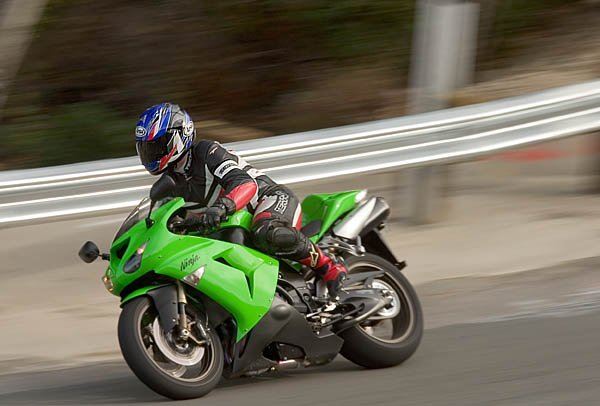
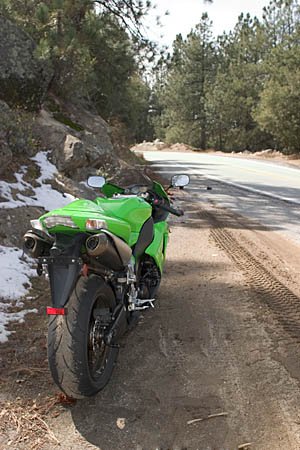
When Kawasaki won our 1000cc sportbike comparison with its then-new 2004 ZX-10R, it defeated some pretty stiff competition, including Yamaha’s R-1, Honda’s CBR1000RR and the traditional class leader, the Suzuki GSX-R1000. The ZX-10R was largely unchanged in 2005. This prior generation bike provided some great thrills during testing, and its razor sharp reflexes were never misinterpreted by our staff as excessive nervousness or head shake. The bike simply did what you asked of it, and it did it without any hesitation.
The immediacy of the previous design lent it a certain charm, but may not have made it the best bike for less experienced riders (not that any 1000cc sportbike is suitable for a less experienced rider). By completely redesigning the ZX-10R just two years after its introduction, Kawasaki had some pretty lofty goals.
Aside from the typical “lighter and more powerful” goal every sportbike manufacturer seems to have with each iteration of the machine (the new ZX-10R is actually, slighly heavier), Kawasaki firmly focused on homologating a superbike race weapon. Although we refer you to our article dated August 31, 2005 for all of the details regarding changes to the 2006 model ZX-10R, certain of them stand out in this regard. A number of the changes directly impact corner exit speed (for racing and otherwise), including a heavier flywheel (to smooth and spread power), as well as a new swingarm pivoting from a new pivot location (based on racing and test rider feedback). Even the engine height in the chassis has changed to alter the bike’s “roll response” to aid turn-in on the race track.
Altered fuel injection contributes to a different engine character (more about that later). Engine response has as much to do with “hooking up” out of corners as chassis design.
The new look of the ZX-10R is something you will have to evaluate. It has a longer, lower look and feel this year. One goal was a reduction in the frontal area and coefficient of drag (did we mention Kawasaki is focused on racing?).
Kawasaki didn’t forget the street rider in this redesign. That horrible tachometer that was virtually impossible to read is gone. In its place is one of the most legible tachometers we have ever seen. Kawasaki got this message.

Although we have already discussed the performance of our test bike at the drag strip here, how does it perform in the real world on the street? In sum, it is a weapon at least as effective as the old model, but offers a different character.
The engine in the 2006 ZX-10R is about as good as it gets. The fuel injection is the best in its class, and transitions from closed throttle to open throttle are as smooth as a well set-up group of carburetors. State-of-the-art.
Power is very linear, and very, very strong! If you step off a 600 and ride the ZX-10R (as I did when we first received the bike), the low-end power delivery will literally shock you. The fact that the power never lets up no matter where the tachometer may be pointing is even more shocking. Is this the best high-performance engine ever fitted to a production motorcycle? It might be.
The chassis for 2006 is calmed down. This isn’t necessarily a bad thing. Indeed, the old bike may have been an acquired taste – do you prefer a double-shot of espresso or a regular cup of coffee? The new chassis is a very fine cup of coffee, but it is not espresso.
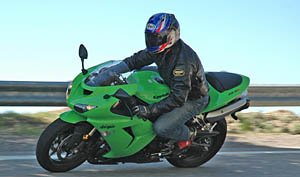
With a bit more weight over the front wheel, and the heavier flywheel smoothing things out, the 2006 ZX-10R is not nearly as prone to wheelies as the older model. The front end will certainly come up if you want it to, but it is less likely to do so when you don’t.
Although it accelerates even more rapidly than the old bike, the new ZX-10R has more stability than the old bike, and would seem to have a larger “window” of chassis set-up that could cover a wider variety of circumstances.
Despite the added stability, the bike seems to change directions as easily as the old one, it just doesn’t do it with the same “snap”. The overall character is more refined and measured, if not more precise.
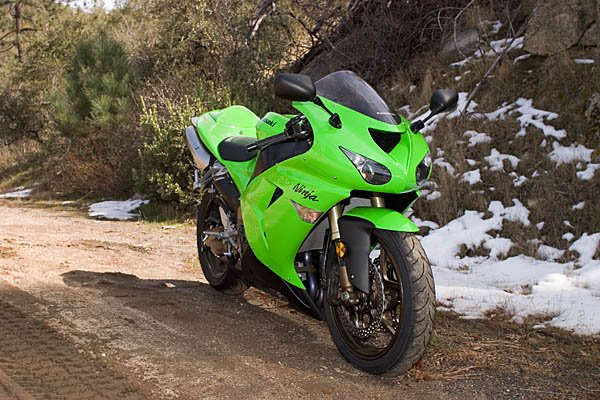
Suspension action seems to be a bit softer and more progressive than last year’s chassis exhibited. It is not a bad street ride, but a ride that nevertheless retains a fair amount of composure when pushed hard. The new ZX-10R has powerful, controllable brakes — among the best we have tested.
Having an Ohlins adjustable steering damper stock is wonderful. We used it, too . . . from near full-hard at the drag strip to a relatively light setting while playing in the canyons, this little Ohlins wonder allowed us to dial in a feel and response that was appropriate to every circumstance.
Although Kawasaki has calmed things down in the chassis department, ergonomics are perhaps a bit more aggressive with bars that feel lower than last year’s, and create more of a stretch for the rider. Wind protection is negligible absent a full race tuck.
The transmission and slipper clutch did everything we asked without complaint, but Kawasaki is definitely a member of the tall-first-gear club. Extra clutch slippage upon leaving a stop deals with a first gear that seems capable of 100 miles per hour or more (we didn’t test it). Although unnecessary for the street (and intended to create a close-ratio gearbox for racing), perhaps this tall first gear is just another way of mellowing out the amazing acceleration this bike offers.
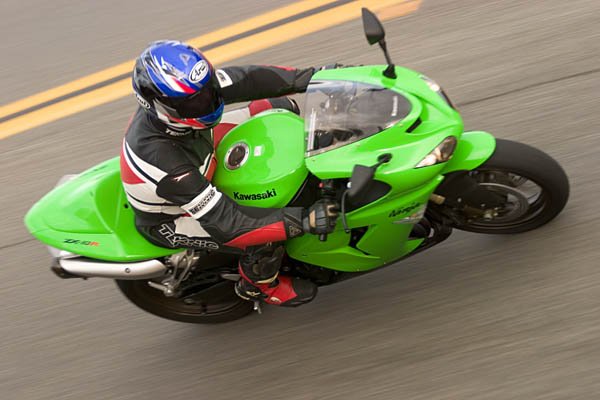
So the 2006 ZX-10R has a viciously fast, but controllable engine stuck into a more mature, sensible chassis. It lacks the immediacy of last year’s bike, but the new ZX-10R is definitely the older, more sensible and capable brother. As a superbike racing platform, it is undoubtedly lightyears ahead. The styling may be controversial (we will let you decide), but this bike is functionally beyond reproach.
The 2006 Kawasaki ZX-10R carries a U.S. MSRP of $11,199. Visit Kawasaki’s web site for additional details and specifications.





